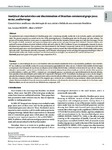Use este identificador para citar ou linkar para este item:
http://www.alice.cnptia.embrapa.br/alice/handle/doc/925389Registro completo de metadados
| Campo DC | Valor | Idioma |
|---|---|---|
| dc.contributor.author | RIZZON, L. A. | pt_BR |
| dc.contributor.author | MIELE, A. | pt_BR |
| dc.date.accessioned | 2016-10-20T21:41:52Z | - |
| dc.date.available | 2016-10-20T21:41:52Z | - |
| dc.date.created | 2012-05-24 | pt_BR |
| dc.date.issued | 2012 | pt_BR |
| dc.identifier.citation | Ciência e Tecnologia de Alimentos, Campinas, v. 32, n. 1, p. 93-97, jan./mar. 2012. | pt_BR |
| dc.identifier.uri | http://www.alice.cnptia.embrapa.br/alice/handle/doc/925389 | pt_BR |
| dc.description | The production and commercialization of Brazilian grape juice is increasing annually, mainly due to its typicality, quality, and nutritional value. The present research was carried out in view of the great significance of Brazilian grape juice for the grape and wine industry. The purpose of this study, therefore, was to assess its composition as well as the discrimination between grape juice and other beverages. Twenty four samples of whole, sweetened, and reprocessed grape juices, grape nectar, and grape beverage were evaluated. Classical variables were analyzed by means of physicochemical methods; tartaric and malic acids, by HPLC; methanol, by gas chromatography; minerals, by atomic absorption spectrophotometry. These products were discriminated by the Principal Component Analysis (PCA). Results show that whole and sweetened grape juices were discriminated from other grape products because they featured higher values of total soluble solids, tartaric and malic acids, most minerals, phenolic compounds, and K/Na ratio, whereas grape nectar and grape beverage presented higher values of ºBrix/titratable acidity ratio. Reprocessed juice was discriminated due to its higher concentrations of Li and Na and lower hue. | pt_BR |
| dc.language.iso | eng | eng |
| dc.rights | openAccess | eng |
| dc.subject | Análise de Componentes Principais | pt_BR |
| dc.subject | Brasil | pt_BR |
| dc.title | Analytical characteristics and discrimination of Brazilian commercial grape juice, nectar, and beverage. | pt_BR |
| dc.type | Artigo de periódico | pt_BR |
| dc.date.updated | 2019-06-14T11:11:11Z | pt_BR |
| dc.subject.thesagro | Bebida | pt_BR |
| dc.subject.thesagro | Tecnologia | pt_BR |
| dc.subject.thesagro | Suco | pt_BR |
| dc.subject.thesagro | Uva | pt_BR |
| dc.subject.thesagro | Analise quimica | pt_BR |
| dc.subject.thesagro | Composicao quimica | pt_BR |
| dc.subject.thesagro | Néctar | pt_BR |
| riaa.ainfo.id | 925389 | pt_BR |
| riaa.ainfo.lastupdate | 2019-06-14 -03:00:00 | pt_BR |
| dc.identifier.doi | http://dx.doi.org/10.1590/S0101-20612012005000015 | pt_BR |
| dc.contributor.institution | LUIS ANTENOR RIZZON, CNPUV (aposentado); ALBERTO MIELE, CNPUV. | pt_BR |
| Aparece nas coleções: | Artigo em periódico indexado (CNPUV)  | |
Arquivos associados a este item:
| Arquivo | Descrição | Tamanho | Formato | |
|---|---|---|---|---|
| RIZZONCTAv32n1p932012.pdf | 270,11 kB | Adobe PDF |  Visualizar/Abrir |









